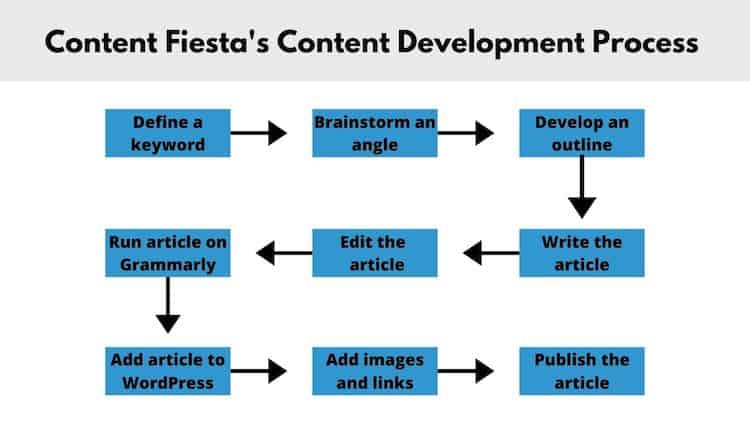Strategic Content Planning: How To Develop Content Strategy in 2024


Do you feel overwhelmed every time you need to publish new content?
You need a content development process that guides your entire workflow from ideation to promotion.
In this article, discover what strategic content planning entails, how it functions, and how you can create one for your company.
Let’s dive in.
Content development is the process of creating content. It includes every step required to publish a piece of content:
Content development is often used as a synonym for content marketing, but this is a mistake.
As a company starts to grow, the harder it becomes to manage its content operations. The more people involved, the harder it is to organize the work. People start missing deadlines, managers assign topics without any purpose, and the content created becomes sloppy.
A content development strategy allows for a streamlined operation, adding clarity and efficiency to its content development process.
Whether you are aware or not, you have a content development process in place. Your goal is to have one that serves your marketing goals. Before you can do so, you need to define a content development strategy.
A content development strategy is not the same as a content development process. While the latter represents the steps people take to create content, the former defines the organization of these steps.
Think about it this way:
If you aren’t aware of your current content development process, then you want to outline it and improve it.
If you are a team of one, then outlining your strategy will be easy to do. This doesn’t mean you shouldn’t do it; you have to.
Six months ago, I didn’t have a content development strategy in place. I just created content when I felt like it. It was a mess.
Then, I outlined a basic content development process. Soon after, I started publishing a 2,000+ words article a week. And I still have time for my client work, for promoting, and much more.
If your content development process involves more than one person, then have each person answer the following questions.
With the answer to each question, you want to create a visual representation of the steps required, adding members responsible for each step along the way.
Here’s an example of my content development process:

As you can see, it’s a one-man show, so it’s quite simple. If I had team members involved (which I may have in the future), it would look like the one from Backlinko:

Once you have outlined the steps you currently take, you want to optimize it.
It’s best to think of your content development process as a conveyor belt where each member is responsible for a few tasks in different stages. Such a division of labor made Henry Ford create one of the most influential companies in history.

Once you have outlined your content development strategy, you will see a pattern that arises from the steps involved. You can call each step as you want, but to simplify it, I have come to organize the entire content development process as a six-step workflow that involves:

The critical element that makes a content development process work is that each step must be seamlessly tied to the next one; it should be clear and easy to implement.
For example, the editor should be responsible for editing a piece once the writer has finished the first draft. If the writer hasn’t completed it by the deadline, it’s best to let the writer hand it once they are ready. If the writer never delivers on time, there’s a problem with the writer or the deadlines, which you must fix from a strategic standpoint. The editor shouldn’t be involved in any task before theirs; the same applies to other people.
What’s more, your content development process must adapt to your company’s capacities and resources and the members that implement it.
Each member must be prepared to handle the tasks and educated if they aren’t. What’s more, you must provide the tools necessary to do their job efficiently—think of a content calendar app, a collaboration tool, etc. If someone has to open several tabs or apps to find something they need, something is wrong.
The entire content development process should connect with a greater content marketing strategy that defines the direction of the efforts. Remember, your content marketing strategy defines the objectives, the process organizes the steps needed to reach them.
Without further ado, let’s explain each of the five steps involved in a content development process.
The first step involves a thorough analysis of the customers you want to target with your content. It goes without saying, but your content should always aim to attract and convert an audience that leads to revenue, not just pageviews.
You should carry out this step before you can implement a successful content marketing strategy. Unlike the other steps, you don’t need to carry out customer analysis regularly. Once a quarter, semester, or year is more than enough to get you started. What’s important is that you base your content ideas from the customer analysis.
To create a customer analysis, you want to compile information on:
To find this information, you want to use tools like:
At the end of this step, you should have a list of target audiences you will write your content to. Their problems and needs will guide the next step.
Content planning involves a separate set of tasks that could take their own separate step. I mix them all within this step for simplicity’s sake, but you can break it down further as you see fit.
On the broadest sense, content planning involves:
To find a topic idea, you want to:
Make a list of all your topics and prioritize them according to some of the following variables:
I usually use the first five of these variables, but I have seen content marketers use more, adding:
These variables differ from each other, so you want to add a numeric value to each variable to compare apples with apples. For example:
These parameters are still entirely subjective, so there will always be room for improvement or discussion. What’s important is that you define between three to five variables, whose parameters you quantify clearly.
Once you have added numeric values to each variable and topic, summarize the column’s results and pick those topics with the highest value.
In our example, you should target the topics in descending order from those that have a nine—high-volume, low-quality competitor content, and quick to create—to those that have a one.
An idea defines the overall concept of the content piece, but the angle is the exact execution that you will take to bring the content piece to life. For example:
There’s no simple way to find a content angle as it depends on the topic, the experience of the writer and/or manager, the industry, and more.
Here’s a short list of rules of thumb I use when I find the angles for my topics:
With the topics defined and prioritized, you want to develop a content calendar. Aim to plan an entire month at a time, at the minimum. You want to have some wiggle room between your publishing dates, so if anything goes wrong, you don’t mess the entire process. This will give time for you and your team to organize themselves properly.
I recommend setting a time, at least once a month, where you—or whoever is responsible for the content development process—define the content you will publish for the following 30 days or more. I usually have at least one month in advance of topics with defined deadlines and three months’ worth of content that can be easily assigned once I see I haven’t missed a single deadline.
Make sure that everyone who is involved in this process is notified and aware of their deadlines. Let them ask questions or share doubts, so everyone is on the same page.
The last part is where you plan the resources needed to do their best job without any interference.
What’s more, discuss the tasks with everyone involved in the content development process and make sure you understand what they are doing. Everyone should be able to collaborate with everyone else without interfering with their work.
Ideally, this entire step should be relatively straightforward. The first time you implement it may look complicated, but as you work on it, it will get progressively easier to understand and act on.
Everything done so far leads us to this step. This is the one everyone obsesses about, but without a clear foundation, it will lead nowhere.
This step can be split into two sub-steps:
If you implement your content creation, then you want to start working by the time your task is due. If you want to learn more about writing great content, please check out the following posts:
If you aren’t responsible for creating your brand’s content, you will have to hire people to do it for you. To do so, you have several options available:
One issue I’ve experienced many times is that two or more people become involved here. A manager checks for… who knows what. Then, an editor checks for the issues I mentioned before.
There’s an overlap of tasks that dilutes the effectiveness of the editor work. Managers and executives can look at the content produced, but it shouldn’t be their job to edit it.
Anyone who’s not professionally trained as an editor should never edit content, except for meaning. That is, they should check whether a piece of content meets its goal; if it speaks to the audience and showcases subject-matter expertise. If it doesn’t, then:
Otherwise, it’s the editor’s job to edit. This involves:
The fact a piece of content is ready to publish doesn’t mean it can be published. In this step, you add the content to your CMS—most likely, WordPress—and format the content appropriately.
If your content is an article, this work includes:
If your content is an ebook, this work will include:
There’s more to this step than it meets the eye, so make sure to assign it enough time so every content piece goes out the door as it should be.
The last step is the part where many content marketers forget. Content without marketing is journalism. You need to plan and execute a content promotion campaign.
This step requires its own strategy, which I won’t explain in this article. On a broad sense, a basic content promotion strategy involves:
Most likely, marketers will be involved in this step. That is:
Don’t let their silos abstain them from participating in your content development process. They should have a saying in it as the promotion is as important as the creation. What’s more, your content creators should also be involved in its promotion, even if that means sharing it on social media.
Promoting content is a never-ending process you need to always work on. The more content you create, the more you should promote both your new and old material.
If you never seem to know what’s happening in your content marketing team, or if you can’t develop a consistent publishing schedule, you need to create a content development strategy.
Use the structure I recommend here, but feel free to adapt it to your own needs. As I said, you can break down each step in many different pieces. Start with the simplest, most basic strategy process—the one laid out here—and increase its complexity as you see you progress.
The better your content development process, the more efficient your content marketing strategy will become. Give it a try; it will change your business.